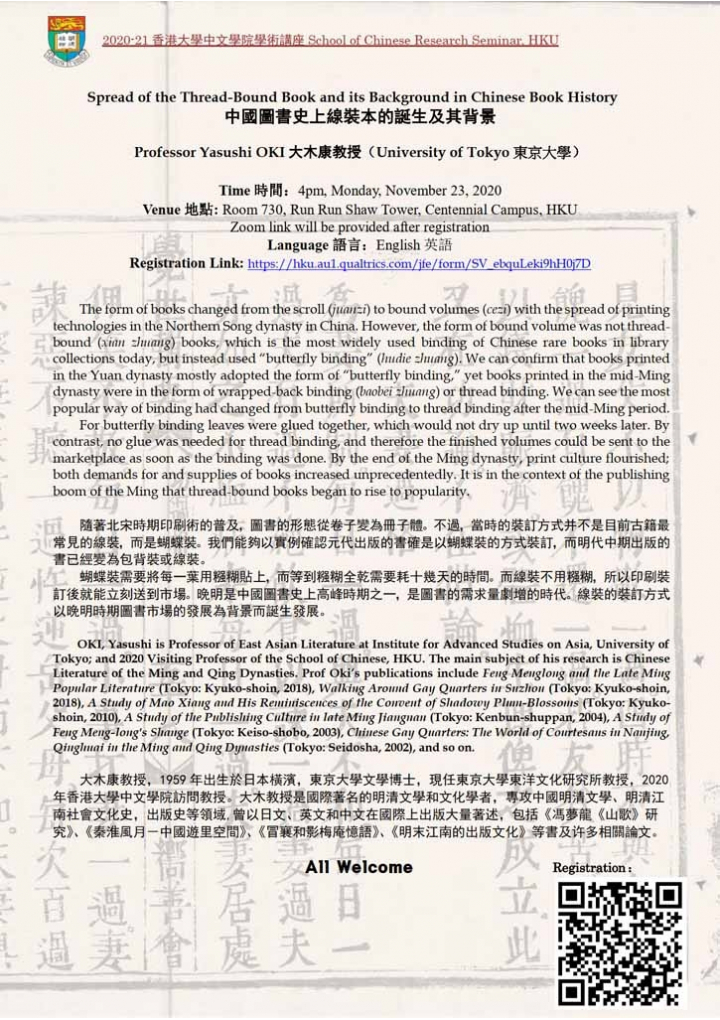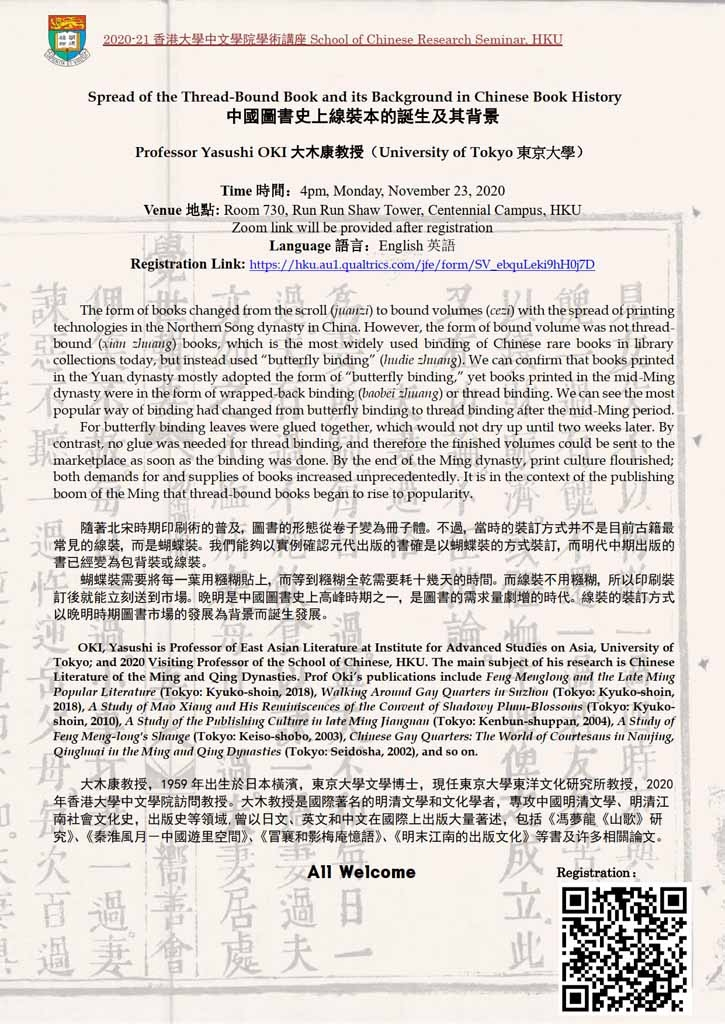中國圖書史上線裝本的誕生及其背景

2020-21香港大學中文學院學術講座School of Chinese Research Seminar, HKU
Spread of the Thread-Bound Book and its Background in Chinese Book History
中國圖書史上線裝本的誕生及其背景
Professor Yasushi OKI大木康教授(University of Tokyo東京大學)
Time 時間:4pm, Monday, November 23, 2020
Venue 地點: Room 730, Run Run Shaw Tower, Centennial Campus, HKU
Zoom link will be provided after registration
Language 語言:English英語
Recording link:
https://hku.zoom.us/rec/share/Jt3Hyq2EG9MjXdLVPnpRC-OWJyHQs46LyFajilIUcMeIqa1syKmQE3sHEHiY3rz2.CnCAUNgLjWPFaxKx
Passcode:4^FZ&&S7
The form of books changed from the scroll (juanzi) to bound volumes (cezi) with the spread of printing technologies in the Northern Song dynasty in China. However, the form of bound volume was not thread-bound (xian zhuang) books, which is the most widely used binding of Chinese rare books in library collections today, but instead used “butterfly binding” (hudie zhuang). We can confirm that books printed in the Yuan dynasty mostly adopted the form of “butterfly binding,” yet books printed in the mid-Ming dynasty were in the form of wrapped-back binding (baobei zhuang) or thread binding. We can see the most popular way of binding had changed from butterfly binding to thread binding after the mid-Ming period.
For butterfly binding leaves were glued together, which would not dry up until two weeks later. By contrast, no glue was needed for thread binding, and therefore the finished volumes could be sent to the marketplace as soon as the binding was done. By the end of the Ming dynasty, print culture flourished; both demands for and supplies of books increased unprecedentedly. It is in the context of the publishing boom of the Ming that thread-bound books began to rise to popularity.
隨著北宋時期印刷術的普及,圖書的形態從卷子變為冊子體。不過,當時的裝訂方式并不是目前古籍最常見的線裝,而是蝴蝶裝。我們能夠以實例確認元代出版的書確是以蝴蝶裝的方式裝訂,而明代中期出版的書已經變為包背裝或線裝。
蝴蝶裝需要將每一葉用糨糊貼上,而等到糨糊全乾需要耗十幾天的時間。而線裝不用糨糊,所以印刷裝訂後就能立刻送到市場。晚明是中國圖書史上高峰時期之一,是圖書的需求量劇增的時代。線裝的裝訂方式以晚明時期圖書市場的發展為背景而誕生發展。
OKI, Yasushi is Professor of East Asian Literature at Institute for Advanced Studies on Asia, University of Tokyo; and 2020 Visiting Professor of the School of Chinese, HKU. The main subject of his research is Chinese Literature of the Ming and Qing Dynasties. Prof Oki’s publications include Feng Menglong and the Late Ming Popular Literature (Tokyo: Kyuko-shoin, 2018), Walking Around Gay Quarters in Suzhou (Tokyo: Kyuko-shoin, 2018), A Study of Mao Xiang and His Reminiscences of the Convent of Shadowy Plum-Blossoms (Tokyo: Kyuko-shoin, 2010), A Study of the Publishing Culture in late Ming Jiangnan (Tokyo: Kenbun-shuppan, 2004), A Study of Feng Meng-long’s Shange (Tokyo: Keiso-shobo, 2003), Chinese Gay Quarters: The World of Courtesans in Nanjing, Qinghuai in the Ming and Qing Dynasties (Tokyo: Seidosha, 2002), and so on.
大木康教授,1959年出生於日本橫濱,東京大學文學博士,現任東京大學東洋文化研究所教授,2020年香港大學中文學院訪問教授。大木教授是國際著名的明清文學和文化學者,專攻中國明清文學、明清江南社會文化史,出版史等領域,曾以日文、英文和中文在國際上出版大量著述,包括《馮夢龍《山歌》研究》、《秦淮風月-中國遊里空間》、《冒襄和影梅庵憶語》、《明末江南的出版文化》等書及许多相關論文。
All Welcome









